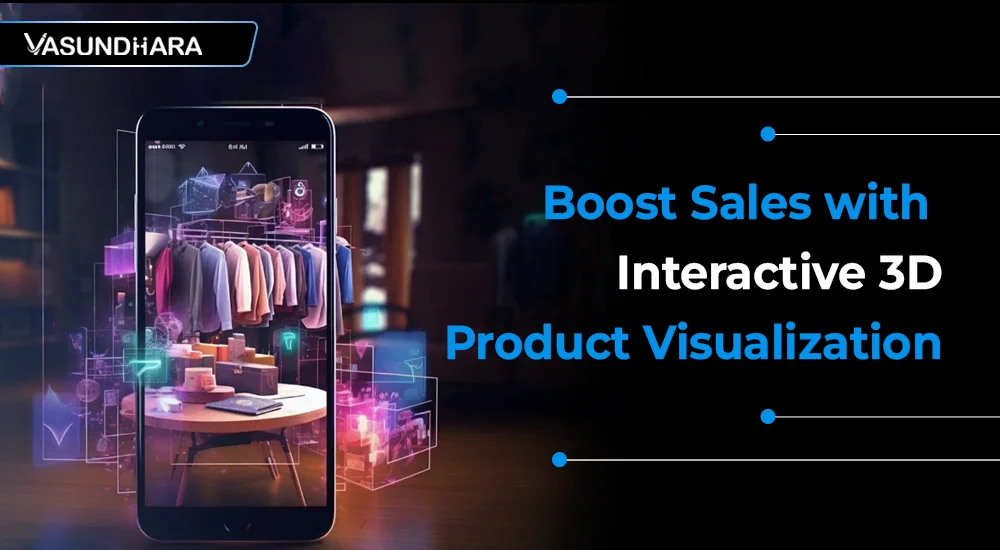Boost Sales with Interactive 3D Product Visualization


- Feb 21, 2024



With the advent of the digital age, visuals are now essential for communicating ideas and shaping customer behavior.
Effective marketing techniques rely heavily on visual material since it is more remembered and interesting than text alone.
In this largely visual world, 3D product visualization has completely changed how companies present their products.
Customers may examine things in previously unheard-of detail thanks to 3D product visualization, which offers a more immersive and dynamic experience than standard static photos or 2D visuals.
The potential of interactive 3D product visualization and how it might increase sales are examined in this blog.
Through an appreciation of the persuasive power of graphics in sales, the distinct qualities of 3D visualization, and its useful use, companies can open up new avenues for consumer interaction and boost sales.
Consumers have a short concentration span in the highly competitive digital marketplace. Visual content is an extremely effective means of captivating audiences and rapidly communicating information.
Captivating images provide a lasting impact and entice viewers to investigate deeper, whether they be on product pages on e-commerce websites or social media posts.
The statistical evidence further supports the importance of visuals in shaping consumer behavior.
It is worth noting that the human brain processes visuals at a rate of 60,000 times faster than text, which emphasizes the profound influence that skillfully designed visuals can exert on the process of making decisions.
As enterprises strive to distinguish themselves in the saturated digital environment through novel approaches, the adoption of 3D product visualization emerges as an inevitable next step.
This segment lays the groundwork for a more comprehensive examination of the influence that 3D visualization may have on sales by connecting the significance of visual content with its potential.
Interactive 3D Product Visualization is a revolutionary tool transforming the digital shopping experience. Unlike static images, this technology enables customers to engage with products dynamically.
By allowing users to manipulate, rotate, and zoom in on products, businesses enhance customer engagement, providing a deeper understanding of their offerings.
From furniture to fashion and beyond, various industries benefit from this immersive approach.
The interactive nature fosters increased trust, confidence, and, ultimately, higher conversion rates.
As technology continues to evolve, businesses should consider integrating Interactive 3D Product Visualization into their strategies, unlocking a new dimension of customer interaction and propelling sales to unprecedented heights.
Interactive 3D product visualization offers a plethora of benefits that can significantly impact a business's marketing strategy and sales performance:
One of the primary advantages of interactive 3D product visualization is its ability to captivate and engage customers.
By allowing users to interact with the product, businesses create a more personalized and memorable experience, leading to increased time spent on product pages and a higher likelihood of conversion.
Static images may leave certain product features open to interpretation, leading to potential misunderstandings.
Interactive 3D visualization eliminates this ambiguity by providing a comprehensive view of the product from all angles. Customers gain a clearer understanding of the product's design, functionality, and features, fostering a more informed purchasing decision.
The transparency offered by interactive 3D product visualization builds trust between businesses and consumers. When customers can explore a product thoroughly before making a purchase, they are more likely to feel confident in their decision.
This trust is crucial for online businesses, where customers cannot physically inspect products before buying.
Implementing interactive 3D product visualization requires careful planning and consideration to ensure a seamless and effective integration into your business strategy. Here are key factors to keep in mind:
Define Your Objectives: Clearly outline the goals and objectives you aim to achieve with interactive 3D product visualization.
Whether it's enhancing customer engagement, reducing product returns, or increasing conversion rates, having a clear purpose will guide the implementation process.
Consider the preferences and behaviors of your target audience. Understanding your customers' expectations and how they interact with online content will help tailor the 3D visualization to meet their needs effectively.
Not all products may benefit equally from 3D visualization. Identify products with unique features, intricate details, or those that customers typically want to examine closely before making a purchase. Focus on items where the interactive experience adds significant value.
The success of interactive 3D visualization hinges on the quality of the models. Invest in professional 3D designers who can create realistic, detailed models that accurately represent your products. High-quality visuals contribute to a positive user experience.
Evaluate the technical infrastructure required for seamless integration.
This includes the capabilities of your website or e-commerce platform, device compatibility, and the speed of loading 3D models. Ensure that the technology aligns with your audience's devices and internet speeds.
Ensure that your interactive 3D product visualization is accessible to all users, including those with disabilities.
Provide alternative descriptions for visuals and consider compatibility with screen readers for a more inclusive experience.
Evaluate the costs associated with implementing and maintaining interactive 3D product visualization.
Consider factors such as software licensing, 3D modeling, and potential updates. Balance the investment with the expected returns and long-term benefits.
Several successful brands across diverse industries have embraced 3D product visualization to enhance their online presence, engage customers, and drive sales.
Here are real-world examples of businesses effectively utilizing 3D product visualization:
In the automotive industry, Porsche utilizes 3D product visualization to provide customers with an immersive view of their cars. Potential buyers can explore the exterior and interior features, customize colors, and even visualize the car in different environments. This interactive experience contributes to a more engaging and personalized car-buying journey.
The furniture giant IKEA has integrated 3D product visualization into its online catalog. Customers can virtually place furniture items in their own homes using augmented reality (AR) technology. This interactive experience helps customers visualize how the products will look in their living spaces, contributing to more informed purchase decisions.
Nike leverages 3D product visualization to showcase its footwear and apparel in an immersive way. Through its online platform, customers can rotate and zoom in on shoes, exploring intricate details and designs. This interactive experience not only enhances the online shopping process but also reinforces the brand's commitment to innovation.
Warby Parker, an eyewear company, uses 3D product visualization to allow customers to virtually try on glasses. By utilizing AR technology, customers can see how different frames look on their faces without visiting a physical store. This approach enhances the online shopping experience and reduces uncertainty about the fit and style of eyeglasses.
Adidas uses 3D visualization to showcase its athletic footwear. Customers can rotate and zoom in on the shoes to examine design elements, materials, and color options. This not only enhances the online shopping experience but also helps customers make more informed choices when selecting athletic footwear.
Want to create these kind of immersive experiences for your customers? Consider partnering with a reliable 3D product rendering company like Vasundhara Infotech.
The future of 3D visualization is poised for transformative advancements driven by emerging technologies.
Augmented Reality (AR) and Virtual Reality (VR) are at the forefront, revolutionizing how users interact with 3D models.
AR enhances real-world environments with digital overlays, allowing users to seamlessly integrate 3D visuals into their surroundings.
VR, on the other hand, creates immersive, virtual environments where users can explore 3D spaces in a more lifelike manner.
Additionally, advancements in artificial intelligence and machine learning contribute to more realistic and dynamic 3D models.
These technologies collectively pave the way for unprecedented levels of user engagement and personalization, promising a future where 3D visualization becomes an even more integral part of our digital experiences.
In conclusion, the benefits of interactive 3D product visualization are multifaceted. From heightened customer engagement to increased trust and conversion rates, this innovative approach transforms the online shopping experience.
Businesses leveraging interactive 3D visuals witness enhanced product understanding, reduced returns, and a competitive edge in the digital marketplace.
The potential for boost sales, customer satisfaction, and brand differentiation makes this an opportunity not to be missed.
To unlock the full potential of interactive 3D product visualization for your business, consider partnering with Vasundhara Infotech.
Our expert team specializes in creating captivating and realistic 3D visuals that elevate your products in the digital space.
From concept to implementation, Vasundhara Infotech ensures a seamless and tailored approach to 3D product visualization, propelling your brand to new heights. Contact us today to embark on a journey of visual innovation and customer engagement with our best-in-class 3D visualization services.
Your products deserve to be experienced in three dimensions – let us bring them to life.
Copyright © 2025 Vasundhara Infotech. All Rights Reserved.